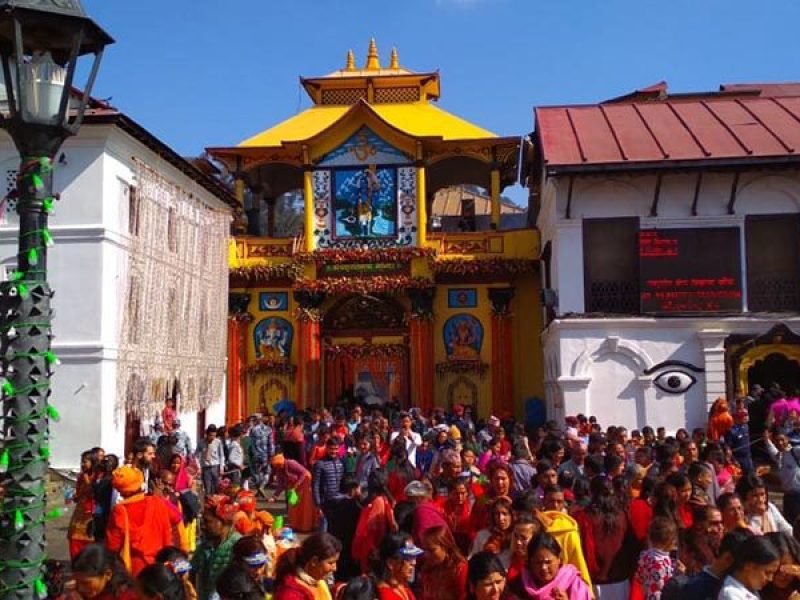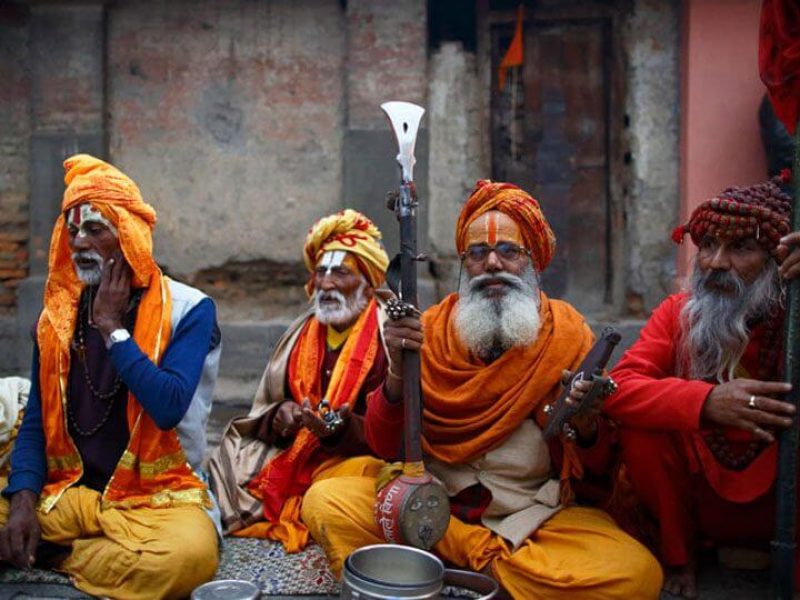Maha Shivaratri, a sacred festival, is a symbol of spiritual communion with the divine and a journey into the depths of consciousness. Believers consider it the night when Lord Shiva performs the Tandava, the cosmic dance symbolizing life, death, and rebirth.
The festival is also known as “Neelkanth Jayanti” and recognizes the selfless act of divine sacrifice. It is a day of fasting, prayer, and sorrow, with the Pashupatinath Temple in Kathmandu at its heart. Devotees gather in droves to pay homage to the divine, with Sadhus, revered ascetics, making pilgrimages to the temple.
As the night descends, the temple area transforms into a kaleidoscope of colors and emotions, with devotees lighting oil lamps, offering milk, honey, and bael leaves to the sacred lingam, and participating in ritualistic worship known as “Rudrabhishek.”
Shivaratri serves as a unifying force, transcending caste, creed, and nationality, promoting communal harmony and social cohesion.
Maha Shivaratri has its roots in ancient Hindu scriptures, particularly the Puranas, which tell the story of Lord Shiva’s cosmic dance, the Tandava. Shiva performed this dance on the night when it symbolizes the cycle of creation, preservation, and destruction, which is reversed.
Believers celebrate the festival as the night when Shiva saved the universe by drinking the poison that emerged during the churning of the ocean (Samudra Manthan), earning him the title “Neelkanth” (the one with a blue throat).
Nepal, with its ancient Hindu traditions and reverence for Lord Shiva, has been a bastion of Shiva worship for centuries. The Pashupatinath Temple in Kathmandu serves as the epicenter of Shivaratri celebrations. It is also one of many popular Hindu pilgrimage places in Nepal.
Over the centuries, the festival has evolved into a grand spectacle of devotion and piety, transcending religious boundaries and uniting people from diverse backgrounds. Today, the festival continues to captivate millions, drawing pilgrims and devotees from far and wide.
Maha Shivaratri is a significant religious festival in Nepal that is celebrated with devotion. Devotees pay homage to Lord Shiva and participate in age-old traditions at the Pashupatinath Temple in Kathmandu, which centers around the festival.
The day begins with a ritual bath in holy rivers, symbolizing spiritual purification and renewal. Many devotees observe a strict fast, abstaining from food and water. Devotees dedicate the morning to elaborate worship ceremonies, known as “Rudrabhishek,” where they offer sacred items to the Shivlinga, the abstract representation of Lord Shiva.

Throughout the day and night, devotees chant prayers, sing bhajans, and recite mantras dedicated to Lord Shiva. The festival is also a time for pilgrims from across Nepal and neighboring countries to seek the blessings of Lord Shiva.
The temple premises come alive with cultural programs, religious discourses, and spiritual gatherings organized by various religious organizations and social groups. Similarly, traditional music and dance performances depict the mythological tales of Lord Shiva and his divine consort Parvati.
Lastly, the festive spirit is enhanced by the Maha Shivratri Mela, a fair held around the temple complex, where religious artifacts, souvenirs, and traditional delicacies are sold by vendors. It is a profound spiritual experience that transcends earthly boundaries and connects devotees with the divine.
Maha Shivaratri is a significant Hindu festival in Nepal, that promotes spiritual purity, devotion, and selfless service. Devotees believe they can attain spiritual purity and seek blessings from Lord Shiva for prosperity, protection, and liberation from the cycle of birth and death by fasting and offering prayers on this auspicious day.
It’s a time of spiritual awakening and enlightenment. The night involves vigil, meditation, and chanting of sacred mantras. This creates an atmosphere for inner reflection and transcendental experiences.
Generally, cosmic energies are believed to be particularly potent on this day, facilitating spiritual breakthroughs and revelations for sincere seekers on the path of self-realization. This festival continues to inspire millions to follow the path of righteousness, compassion, and inner peace.

They belong to various monastic orders, each with its own rituals, practices, and philosophies. Sadhus’ distinctive appearance, including saffron-colored robes, dreadlocks, rudraksha bead necklaces, and ash, serves as reminders of their renunciation.
Furthermore, they lead a nomadic lifestyle, relying on alms for sustenance and often dwelling in caves, forests, or makeshift shelters. During Shivaratri, Sadhus perform elaborate puja ceremonies, chant sacred mantras, and offer prayers at temple shrines. They serve as spiritual guides, offering counsel, blessings, and teachings to devotees seeking spiritual guidance.
In conclusion, Maha Shivaratri is a significant religious festival in Nepal, celebrated for its faith, devotion, and spiritual awakening. It is a time for introspection, purification, and seeking divine blessings from Lord Shiva. The festival inspires millions to embrace righteousness, compassion, and inner peace.
Trek Me Nepal offers guided tours of Pashupatinath Temple and Himalayan landscapes, blending adventure and spiritual exploration. Therefore, this festival serves as a gateway to self-discovery, celebrating life, love, and the eternal dance of creation.
Hindus annually celebrate Maha Shivaratri in reverence to Lord Shiva, dedicating the festival to his divine attributes and cosmic significance. In Nepal, it holds immense cultural and religious importance, attracting devotees from all over the world to participate in the celebrations at the sacred Pashupatinath Temple and other revered shrines.
Maha Shivaratri originates from ancient Hindu scriptures, especially the Puranas, which tell stories of Lord Shiva’s divine deeds. For centuries, Nepalese people have celebrated the festival, evolving traditions to reflect the country’s cultural heritage.
Maha Shivaratri celebrations in Nepal typically involve fasting, ritual bathing, prayers, and offerings at temples dedicated to Lord Shiva. Devotees gather at Pashupatinath Temple and other sacred sites in Kathmandu. Elaborate worship ceremonies, cultural programs, and nightlong vigils occur in a vibrant atmosphere of devotion and piety.
Yes, Maha Shivaratri in Nepal is characterized by several unique traditions and customs. Devotees offer milk, honey, bael leaves, and other sacred items to the Shivlinga. They perform the ritualistic worship called “Rudrabhishek.” Devotees observe a nightlong vigil and meditation seeking spiritual enlightenment and blessings from Lord Shiva.
Travelers can experience Maha Shivaratri by visiting Nepal during the festival period and joining the festivities at the Pashupatinath Temple and other revered sites. Guided tours or trekking packages offered by travel companies like Trek Me Nepal provide immersive experiences.